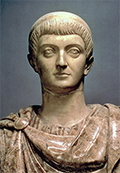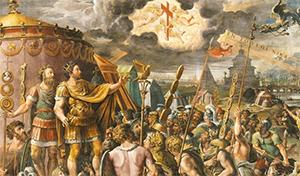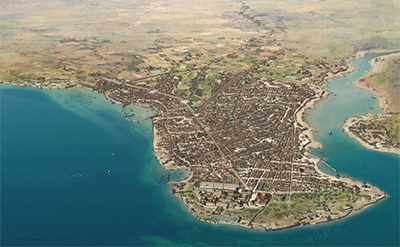The Roman Emperor Constantine
Constantine was Emperor of Rome in the 4th Century. A unifier and strong personality, he is perhaps most well-known in Western circles for granting religious tolerance to Christianity. 
He was born Flavius Valerius Constantinus on Feb. 27, 280, in Naissus, Moesia (in what is now Serbia). His father, who shared his son's name, was a military man, and it is through the father that the son came to occupy a position of so high a responsibliity at such a young age. The boy spent much time at the emperor's court, learning Greek and Latin and philosophy. He was also a soldier, serving on campaign along the Danube and in Mesopotamia and Syria. The elder Constantinus had left Helena, the boy's mother, in 289, on the orders of the emperor Diocletian, to marry someone else, the stepdaughter of Maximian, who was co-emperor and in charge of the Western part of the Empire. In 293, Diocletian's plan for the Tetrarchy–a two-tier, two-manned system of leadership–came to fruition and Constantinus became Caesar, or deputy emperor in the West. In 305, both Diocletian and Maximian, the Augusti (co-emperors) abdicated, and their Caesars, Constantinus and Galerius, became co-emperors. Significantly, the younger Constantinus and Maxentius, the son of Maximian, did not follow in their fathers' footsteps and become Caesars. Instead, Galerius's nephew, Maximinus, and Severus became the co-emperors-in-waiting. Constantinus became Constantius I, and his son joined him as the new emperor went on campaign in Britain. The Roman Army fought against the Picts beyond Hadrian's Wall for a the better part of a year. On July 25, 306, Emperor Constantius died. One of his last proclamations was to declare his desire for his son to succeed him as Emperor in the West. Roman troops in Britain and Gaul approved this acclamation. Naming himself Emperor Constantine, he led his troops in a series of successful actions against the Picts. Once the frontier in Britain was secure again, he went to Gaul, where he led more troops to more victories, this time over the Franks. After defeating the Frankish kings Ascaric and Mreogais, Constantine embarked on a major strengthening of the Tetrarchic capital, Trier, adding a large baths and augmenting the already large imperial palace. Rome had other ideas about who was emperor, however, naming as the next Augustus in the West not Constantine but Severus. He was already Caesar and so took the next step, as presumably Diocletian had wished it. Also stepping into the succession fray was Maxentius, Maximian's son, who proclaimed himself emperor in October 305. Galerius and Severus united in opposition to Maxentius, and Severus and his soldiers marched on Maxentius; however, those soldiers, who had previously been loyal fo Maximian, preferred his son to Severus and so deserted their present commander and, turning on him, had him imprisoned. Horrified at this turn of events, Maximian left his retirement and threw in his lot not with his son but with Constantine, even offering his daughter Fausta to the young son of Constantius. Rather than get involved in the internecine struggle within Italy, however, Constantine led his soldiers in raids along the Rhine, fighting against the Bructeri and the Franks. On November 11, 308, Diocletian left his retirement estate to attend the council that Galerius had called in order to forestall any more civil-war-like bloodshed. The result of that council for Constantine was an official demotion (although none but Maximian had granted him the title of Augustus) to Caesar. The official Augustus in the West was Licinius, an old friend of Galerius. Maximinus, again incensed at being ignored, demanded more recognition. He did not get it. Maximian himself in 310 sought to reassert his power, telling the world that Constantine was dead and assuming the honors that had been bestowed on him. Constantine, very much alive, left off his Rhine campaigns and marched with his men to confront Maximian. The latter fled to Massilia, in hopes of withstanding a siege. Constantine had many friends in the city (which is now Marseille), and they opened the gates of the city to him. Constantine had Maximian captured alive and encouraged him to arrange for his own death; the aged commander complied, in July 310. In response, Maxentius vowed to avenge his father's death. Constantine, seeing the need for allies, offered his sister Constantia as a bride to Licinius, who accepted both the marriage and the alliance. Constantine then set about taking city after city, angling toward an ultimate confrontation with Maxentius. First Augusta Taurinorum (Turin), then Milan, then Brixia, then Verona, and then Aquileia and Modena and Ravenna fell to Constantine's forces. Maxentius, meanwhile, ensconced himself in Rome, ready to withstand a siege. Although he had the city and its walls and had invalidated all bridges across the Tiber, he still felt the need to consult the keeper of the Sibylline Books, in order to get some guidance from the proclamations of the oracles therein. The response, that "the enemy of the Romans would fall," convinced him that he would have the upper hand if he confronted Constantine in the field and so Maxentius and his army left their nearly impregnable walled city of Rome and took the fight to Constantine. 
Maxentius had a large number of soldiers in his army. In fact, he had nearly twice as many men as Constantine had fighting for him. What Maxentius and his men saw when Constantine and his men entered the fray on October 28, 312, at the Battle of the Milvian Bridge was that, at Constantine's direction, his men had marked their shields and standards with a strange symbol, a combination of an X and what looked to be the letter P. This was, in fact, the Chi-Rho, a symbol associated with Jesus, and Constantine later said that he had a vision in which he was directed to so adorn his men's equipment. Thus equipped and accompanied, Constantine's men scored a major victory, driving the men of Maxentius and even the great commander himself into the Tiber River. Among the mass of flailing arms and legs, Maxentius died, as did a great many of his soldiers. (He later had built in Rome a triumphal arch to commemorate this victory.) As it appeared to have turned out, Maxentius, not Constantine, was "the enemy of the Romans." The following day, Constantine entered Rome in a triumphal procession. He declared all laws enacted by Maxentius void and disbanded both the Praetorian Guard and the Imperial Horse Guard. Firmly in control of the Western half of the Empire, Constantine set about removing Maxentius's name from the record books and from the sides of buildings, rededicating buildings in his own name. In 313, he met Licinius in Milan and cemented their alliance. The emperors also jointly issued the Edict of Milan, which outlined a policy of tolerance for Christianity and all other religions. This was a nearly complete reversal from the persecutions of Christians ordered by Diocletian just a few years before. The peace between the Augusti did not last. Licinius had defeated his remaining rival in the East, Maximinus, but then countenanced an assassination attempt on Constantine and ordered some statues of him destroyed. The two co-emperors fought each other at the Battle of Cibalae and at the Battle of Mardia, in 314–317 and ended up with another peace agreement that involved naming their sons as Caesars. Again, the peace did not last. Again, the two co-emperors came to blows, in 324 at the Battle of Adrianople, and at the Battle of the Hellespont and at the Battle of Chrysopolis. Constantine emerged the victor and accepted Licinius's surrender with a vow to letting him live in peace as long as he kept the peace. The very next year, Constantine found evidence of yet another plot against him by Licinius and ordered the latter arrested and then executed. 
Finally alone at the top, Constantine chose as his new capital Byzantium, an older Greek city. He renamed it Constantinopolis (in English "Constantinople"), and this became one of the world's great cities. He ordered a grand building and rebuilding program, repairing damaged walls and buildings and installing cisterns and other relative comforts. In his new headquarters he ordered built a large Christian church, the Church of the Holy Apostles, along with temples to the gods of other religions and many statues of famous generals like Alexander the Great, Julius Caesar, Augustus, Diocletian. Constantine did not miss the opportunity to have erected statues of himself. He organized a major gathering of Christian religious figures at the Council of Nicaea in 325. Out of that council came some major agreements on doctrine that reverberated throughout the Christian world. One of these, the Nicene Creed, is a staple of many Christian worship services to this day. Constantine went to war again in 328, fighting the Goths and Sarmatians for a few years, alongside his son Constantius II. They later captured territories lost to the Dacians but did not have the resources to conquer Persia. The famed emperor died on May 22, 337, in Ancyrona; he was 57. His three surviving sons succeeded him as joint rulers of the Empire. |
|
Social Studies for Kids
copyright 2002–2026
David White




